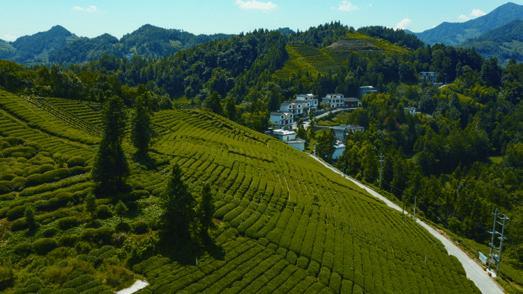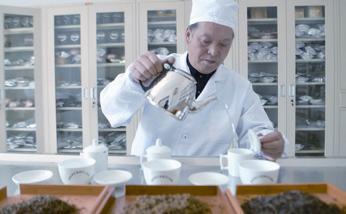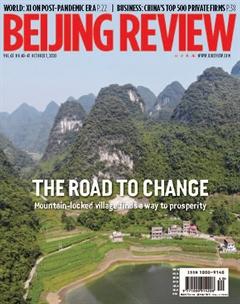Green Leaves,Gold Mines
By Zhao Piao

If you ask the locals to name one thing that has played a key role in shaking off poverty in Enshi Tujia and Miao Autonomous Prefecture in Hubei Province, central China, many would reply, “Tea.”
The warm and humid climate, plenty of rainfall and rolling hills make this area an ideal place for growing tea. But what has made this particular region stand out among numerous tea-growing areas in the country is its efforts in developing rare and high-quality teas.
At an international tea expo held in Shanghai on August 27-30, there were nearly 500 tea companies from 69 prominent teaproducing areas across China. Among them, 35 companies were from Enshi, which is something that its people could hardly have imagined just 10 years ago.
Nanmu Village in Enshi did not venture into tea growing from traditional crop planting until Tian Yunqi was elected head of the villagers committee in 2008.
Native to the village, Tian left home to work in the city when he was young. After making some money, he returned, hoping to help the village out of poverty. At the time, villagers lived on very limited arable land growing grain crops. Although Lichuan has a long history of tea production, poor transportation had blocked Nanmu, surrounded by mostly barren mountains, from the industry.
Tea teams
Tian saw new opportunities after the completion of a newly paved road to the village. With support from the local government, he announced a bold plan: reclaiming the farmland and the barren mountains to grow tea. Villagers mostly responded negatively, arguing that tea was not food. “If we cant sell tea and get money to buy food, what can we eat?” they asked. Tian thought about this. Even if they could grow tea and fi nd a market, the profi t might be very low based on regular market prices and relatively higher transportation costs for the remote village.
They had to grow some special tea varieties with higher profi t margin, Tian thought. He turned to Hu Jiaxiong, Deputy Director of the Lichuan Tea Bureau, for recommendation of tea breeds with “high yield and a good market.”Hu introduced him to a low-yield breed instead and persuaded him to give it a try.
The breed was a black tea with cream down, which is the effect of precipitation formed after the tea cools down and a sign of high quality. Hu said that it was found in a general survey of tea species in Enshi in the early 1980s, but since the yield is very low, few people wanted to grow it before 2000.
Encouraged by the market potential of the breed, Tian bought over 20,000 seedlings and planted them in a tea garden with other breeds.But good results didnt come easily. Compared with other tea breeds, the creamed down tea leaves are much larger and thicker and require much more skill for processing. The villagers couldnt do it and all the efforts in the fi rst year were ultimately wasted.
Tian used his own money to compensate the financial losses of the tea growers and sought solutions from experts. Qiu Jianhong, the chief tea maker from a leading tea company in Lichuan, happened to be conducting a study on this very issue.
Qiu formed a team to work on this problem in 2009. They fi nally discovered that it was the withering in the processing that caused the problem. Withering is the first and a key step in black tea processing, where tea leaves are spread out in a thin layer to dry. It is hard to wither the leaves evenly by hand, which greatly affects the teas taste.
Qiu and his team invented a special withering machine for this tea breed that proved to be very successful. After this problem was solved, the tea gained popularity among more consumers. Local tea companies then joined in poverty alleviation efforts. They paired with poor households providing financial and technical support to tea plantations, gradually making the tea the pillar industry.
In April 2018, the villages cream down black tea was the official tea of the second China-India informal summit held in Wuhan, capital city of Hubei in central China. Now, every household in the village plants tea, expanding the tea plantation from 53 hectares to over 167 hectares, including 16 hectares for the special cream down black tea. “Today, the whole village has bid farewell to poverty,” Tian told Beijing Review. “The average annual disposal income of villagers exceeds 13,000 yuan ($1,860) and half of the households now own cars.”
Tradition to production line
Zhang Wenqi, a tea entrepreneur in Enshi, attended the tea expo in Shanghai in August and the tea he brought with him sold out soon. Zhang is from Jiangsu Province in east China. In 2004, he went to Enshi with the intent to invest in tourism. As a tea lover, he specifi cally wanted to buy a green tea unique to Enshi, which was included in the top 10 tea breeds in China in 1965.
But Zhang couldnt fi nd the tea in any local market. He soon learnt that due to complicated processing techniques, the production of that tea couldnt be mechanized, while manual processing was too time consuming and labor intensive. Since the mid-1990s, the tea had virtually disappeared from the market.

This changed Zhangs initial investment plan from tourism to tea production. In 2005, he set up a tea company and worked to resume the traditional green tea processing. Luckily, there were some senior tea makers to transmit the skills. Yang Shengwei, born in 1937, was one of them. After retiring from an agricultural school in Enshi, he devoted himself to the development and promotion of Enshi tea culture. He still loves to demonstrate the complicated tea picking and processing skills at tea gardens, companies and schools.
With the expertise of these skillful tea makers, the company finally realized mechanized production of the special green tea in 2008. In addition, the opening of expressways and railways ushered in more opportunities for the teas distribution. In 2019, its annual output was 1,820 tons and the brand value surpassed 2 billion yuan ($285 million). In 2019, it was the offi cial tea of the Seventh International Military Sports Council Military World Games held in Wuhan.
In July 2015, Zhang invested in the establishment of the fi rst tea museum in Enshi. “With the display of tea culture, tea making skills, and tea ceremony performances, it has promoted the integrated development of tea and tourism,” Zhang said.


